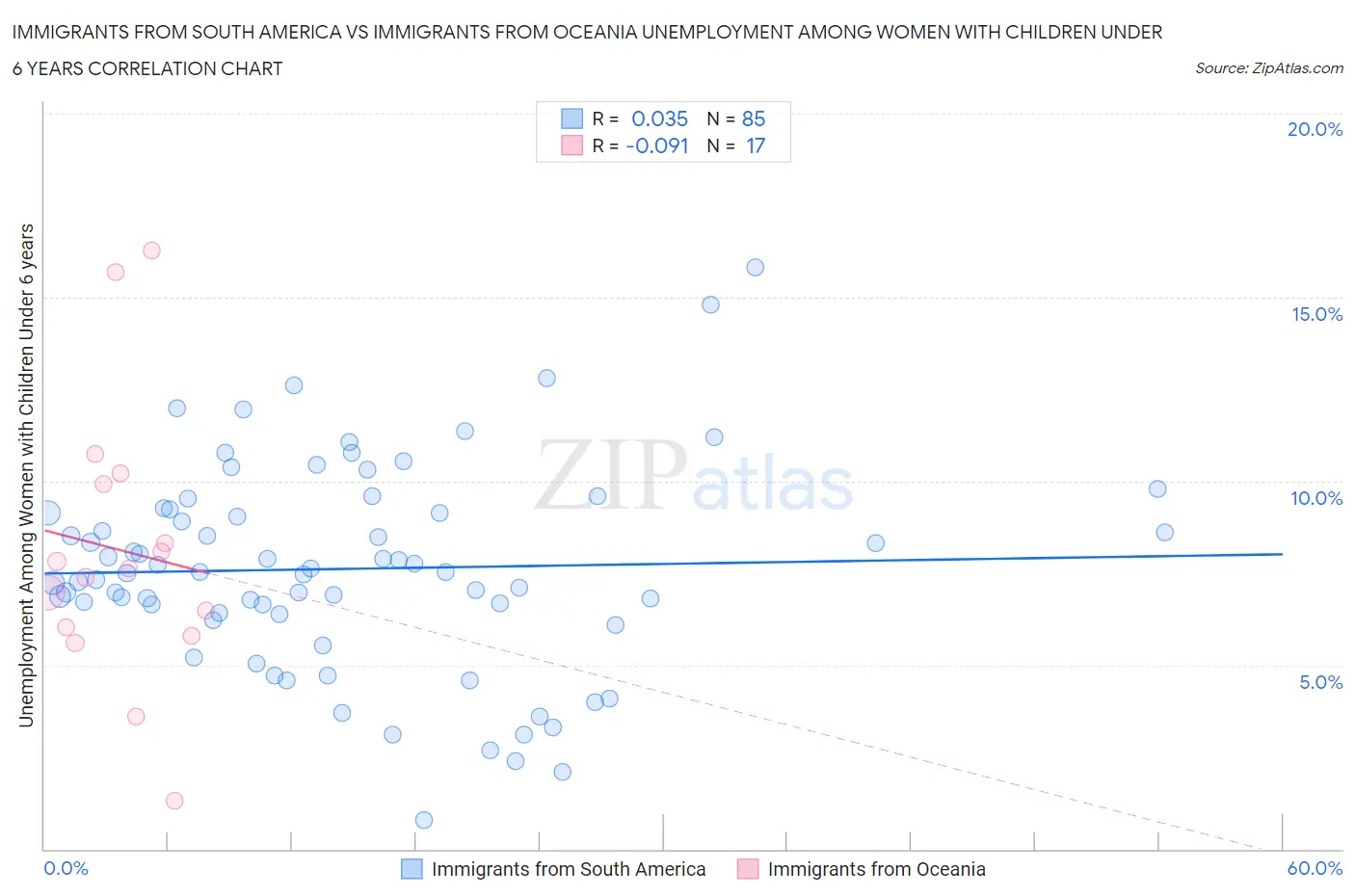Immigrants from South America vs Immigrants from Oceania Unemployment Among Women with Children Under 6 years
COMPARE
Immigrants from South America
Immigrants from Oceania
Unemployment Among Women with Children Under 6 years
Unemployment Among Women with Children Under 6 years Comparison
Immigrants from South America
Immigrants from Oceania
7.6%
UNEMPLOYMENT AMONG WOMEN WITH CHILDREN UNDER 6 YEARS
65.6/ 100
METRIC RATING
165th/ 347
METRIC RANK
7.5%
UNEMPLOYMENT AMONG WOMEN WITH CHILDREN UNDER 6 YEARS
78.4/ 100
METRIC RATING
147th/ 347
METRIC RANK
Immigrants from South America vs Immigrants from Oceania Unemployment Among Women with Children Under 6 years Correlation Chart
The statistical analysis conducted on geographies consisting of 350,771,167 people shows no correlation between the proportion of Immigrants from South America and unemployment rate among women with children under the age of 6 in the United States with a correlation coefficient (R) of 0.035 and weighted average of 7.6%. Similarly, the statistical analysis conducted on geographies consisting of 243,645,085 people shows a slight negative correlation between the proportion of Immigrants from Oceania and unemployment rate among women with children under the age of 6 in the United States with a correlation coefficient (R) of -0.091 and weighted average of 7.5%, a difference of 1.1%.

Unemployment Among Women with Children Under 6 years Correlation Summary
| Measurement | Immigrants from South America | Immigrants from Oceania |
| Minimum | 0.80% | 1.3% |
| Maximum | 15.8% | 16.3% |
| Range | 15.0% | 15.0% |
| Mean | 7.6% | 8.1% |
| Median | 7.5% | 7.6% |
| Interquartile 25% (IQ1) | 6.4% | 5.9% |
| Interquartile 75% (IQ3) | 9.2% | 10.1% |
| Interquartile Range (IQR) | 2.8% | 4.2% |
| Standard Deviation (Sample) | 2.8% | 3.8% |
| Standard Deviation (Population) | 2.8% | 3.7% |
Demographics Similar to Immigrants from South America and Immigrants from Oceania by Unemployment Among Women with Children Under 6 years
In terms of unemployment among women with children under 6 years, the demographic groups most similar to Immigrants from South America are Ugandan (7.6%, a difference of 0.020%), British (7.6%, a difference of 0.050%), Belgian (7.6%, a difference of 0.15%), Immigrants from Lithuania (7.5%, a difference of 0.24%), and Immigrants from Western Asia (7.5%, a difference of 0.36%). Similarly, the demographic groups most similar to Immigrants from Oceania are Japanese (7.5%, a difference of 0.050%), Immigrants from Brazil (7.5%, a difference of 0.11%), Colombian (7.5%, a difference of 0.22%), Aleut (7.5%, a difference of 0.23%), and Immigrants from Peru (7.5%, a difference of 0.33%).
| Demographics | Rating | Rank | Unemployment Among Women with Children Under 6 years |
| Japanese | 78.9 /100 | #146 | Good 7.5% |
| Immigrants | Oceania | 78.4 /100 | #147 | Good 7.5% |
| Immigrants | Brazil | 77.3 /100 | #148 | Good 7.5% |
| Colombians | 76.1 /100 | #149 | Good 7.5% |
| Aleuts | 76.0 /100 | #150 | Good 7.5% |
| Immigrants | Peru | 74.9 /100 | #151 | Good 7.5% |
| Bangladeshis | 74.8 /100 | #152 | Good 7.5% |
| Uruguayans | 74.7 /100 | #153 | Good 7.5% |
| Northern Europeans | 74.3 /100 | #154 | Good 7.5% |
| South Americans | 74.1 /100 | #155 | Good 7.5% |
| Immigrants | Southern Europe | 73.2 /100 | #156 | Good 7.5% |
| Peruvians | 72.3 /100 | #157 | Good 7.5% |
| Croatians | 71.9 /100 | #158 | Good 7.5% |
| Immigrants | Philippines | 71.3 /100 | #159 | Good 7.5% |
| Bolivians | 70.8 /100 | #160 | Good 7.5% |
| Immigrants | Western Asia | 70.2 /100 | #161 | Good 7.5% |
| Immigrants | Lithuania | 68.8 /100 | #162 | Good 7.5% |
| British | 66.3 /100 | #163 | Good 7.6% |
| Ugandans | 65.8 /100 | #164 | Good 7.6% |
| Immigrants | South America | 65.6 /100 | #165 | Good 7.6% |
| Belgians | 63.5 /100 | #166 | Good 7.6% |